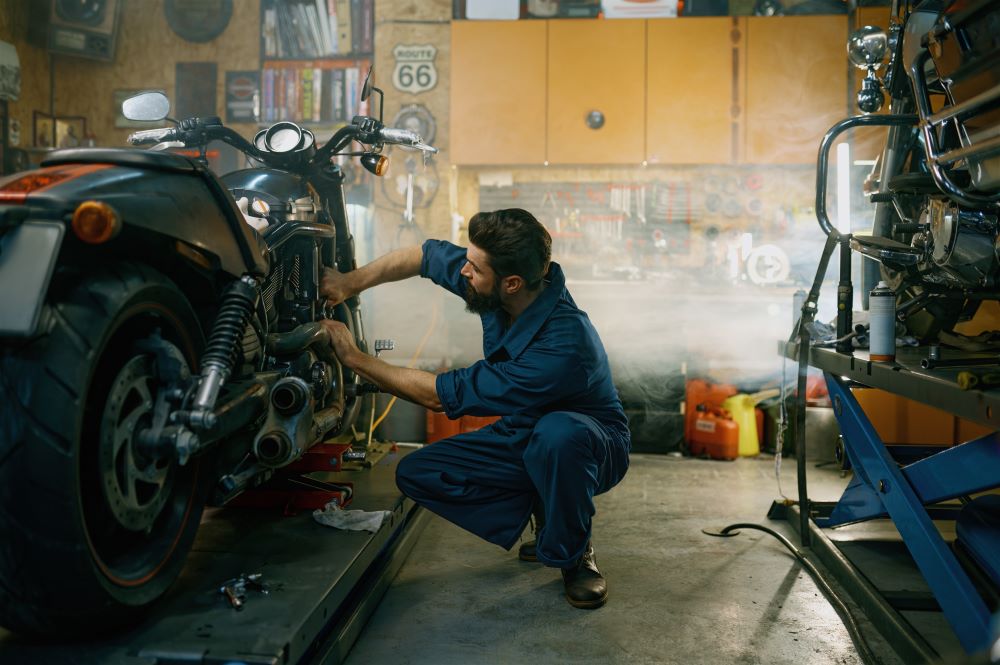9000+ Cashless Garages
96% Claims Settled (FY 24-25)

9000+ Cashless Garages
96% Claims Settled (FY 24-25)



Riding a bike can be exciting, but sometimes it comes with certain challenges. From flat tyres to grinding brakes, the common problems associated with bikes can turn a smooth ride into quite a frustrating event.
Yet, a few preventive tips will help you keep your bike in top condition and enjoy a smooth ride without fuss. This article will explore common bike problems and practical tips for preventing them.


Like any machine, motorcycles can develop issues over time due to wear and tear, poor maintenance, or external factors. While some problems are minor and easily fixable, others require professional attention. Here are nine common motorcycle problems and simple solutions to keep your ride smooth and hassle-free:
Battery problems are the most frequent issue with motorcycles. Most motorcycles, except high-end modern models, still use Sealed Lead-Acid Batteries. Lead-acid batteries can't hold a charge if they sit unused for too long.
However, modern lithium-ion batteries work differently from lead-acid batteries. Lead-acid batteries are sensitive to different conditions. They are non-deep cycle batteries.
Solution:
Always disconnect battery terminals whenever your bike remains unused for an extended time.
Connect your motorcycle battery to an intelligent battery charger to keep it in good condition during storage. This helps maintain the charge and ensures it works properly when reinstalling it on your bike.
Motorcycle engines experience performance issues due to poor maintenance, dirty air filters, and worn spark plugs. The air filter blocks airflow, reducing engine efficiency and vehicle power. A worn spark plug can cause problems with the ignition system, which may lead to engine misfires and trouble starting the engine.
Engine performance drops when contaminants and old fuel clog fuel injectors and carburettors. Engine overheating shows there's a problem with the cooling system. This often means the radiator is damaged or there's not enough coolant.
Solution:
Replace or regularly clean the air filter to maintain proper airflow conditions.
Scheduled replacement of spark plugs leads to consistent ignition operations.
To prevent clogging, the fuel system must remain clean using high-quality fuel.
Regular checks of engine temperature will stop overheating conditions, which threaten engine components.
Motorcycle brake systems usually fail due to worn pads, dirty hydraulic fluid, or damaged hydraulic lines. Brake fluid exchanges moisture, diminishing its power to brake correctly and creating the risk of brake failure.
Air bubbles affect the hydraulic system's performance. They make brake pedals feel spongy and misalign the brake discs, leading to uneven braking. When owners disregard their motorcycles' brake issues, dangerous riding conditions will emerge.
Solution:
Regular pad inspections followed by replacements will guarantee proper braking performance.
Replace old brake fluid and flush the system. Follow the manufacturer's instructions to avoid fluid contamination.
Check brake lines regularly for leaks. Also, make sure brake components are aligned properly.
Damage to the motorcycle tyres is also one of the most common problems. This happens due to bad road conditions, wrong tyre pressures, and natural ageing. Underinflation makes driving unsafe because it reduces traction and handling. On the other hand, overinflation increases the risk of three blowouts.
The condition of the wheels deteriorates when they develop bent rims that reduce vehicle stability. Riders who use damaged wheels and worn-out tyres increase the chance of motorcycle accidents.
Solution:
The correct tyre pressure should match the manufacturer's specifications.
The inspection of tyre tread depth should be followed by tyre replacement when the tread depth reaches unsafe levels.
Vehicle owners should check their wheels often for cracks, punctures, and sidewall damage.
Balance and align your wheels regularly for a smooth drive.
Mechanical stress causes a motorcycle's chain and sprockets to wear out naturally over time. When a chain moves freely, power transfer becomes inefficient. This happens due to poor lubrication or bad installation. A tight chain transmission puts too much stress on the drivetrain, which can shorten its lifespan.
Sprockets and chains should be replaced simultaneously since separate replacements can lead to chain-related system breakdowns. Dirt and other debris promote rapid damage to these components.
Solution:
Regularly cleaning and applying lubricants helps your chain last longer.
Verify and modify your chain tension by following the manufacturer's guidelines.
Replacing chains and sprockets as a combined unit guarantees optimal power transmission operation.
High acceleration speeds should be avoided. This is because they create unnecessary pressure on drivetrain components.
With time, damage to motorcycle suspension systems also occurs. Shocks can cause oil leaks, failure of seals, and suspension calibration issues. A suspension failure causes several issues. You’ll notice less comfort and poor handling.
The signs of suspension failure include a vehicle bouncing excessively with imperfect tyre distribution and labouring when turning. System stability and proper control remain possible with regular maintenance.
Solution:
Shock absorbers should be checked for any signs of leakage, and you should replace worn-out seals during service.
Suspension settings need adjustments per rider weight in combination with the existing terrain.
Regular inspection of fork oil levels and periodic oil replacement must be performed.
Maintenance calls for the appropriate alignment of suspension elements to stop parts from wearing unevenly.
Motorcycles encounter regular electrical problems, such as battery failures, faulty wiring systems, and light malfunctions. Most motorcycles use lead-acid batteries to store their electrical power. However, these batteries perform worse as they age.
Loose wiring connections and corroded terminals cause power loss and electrical failures. When alternators or regulators fail, the charging system becomes faulty, resulting in unexpected power loss to the battery.
Solution:
Check for deterioration along the battery terminals while performing regular cleaning.
Wiring connections need to stay secure without any damage.
The battery needs replacement after 2-3 years or whenever it shows signs of malfunction.
When injectors get blocked, the motorcycle's fuel system can experience issues. This often happens due to carburettor problems or contamination in the fuel system. Deposits in fuel lines restrict uniform fuel flow, reducing fuel efficiency and engine performance.
Ethanol-blended gas can cause water to build up. This can cause starting problems for bikes, raise the risk of corrosion, and affect fuel efficiency. Regular maintenance is essential to prevent it.
Solution:
Clean and high-quality fuel will prevent clogging.
To keep fuel performance strong, clean carburettors and injectors regularly. This helps maintain their efficiency.
Draining fuel and servicing the fuel system will protect your motorcycle from contamination when it is stored for an extended period.
This motorcycle issue mainly causes leaks, rust, and blocked pipes. When an exhaust system is damaged, it harms engine performance and increases motorcycle noise. High humidity causes irrational corrosion, which damages pipes and lets more pollutants escape.
Excessive noise and changes in exhaust sound point to one of two possibilities: loose fittings or system leaks. A blocked catalytic converter directly results in performance decreases and higher fuel costs.
Solution:
Regular inspection of exhaust pipes should focus on searching for rust damage and any signs of external degeneration.
Check exhaust leaks and tighten all loose bolts.
The damaged mufflers and catalytic converters must be replaced as soon as possible.
In humid weather, take longer rides instead of short trips. This helps stop condensation from forming inside the exhaust.
Regular maintenance keeps your motorcycle safe, running smoothly, and easy to care for. You can enjoy a defect-free, longer-living bike with simple checks and routines. Here are some of the key maintenance tips you must follow:
Motorcycle riders encounter some common problems occasionally. However, those can be avoided with essential maintenance and an occasional visual inspection. If you own a bike or are considering purchasing one, being aware of these issues can help ensure you don't run into them. Additionally, you can enjoy your rides rather than spending more time fixing them.